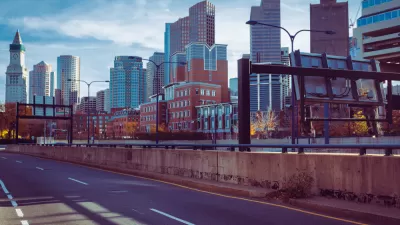In Boston, the MBTA and city planners are weighing the benefits and drawbacks of creating transit-oriented development along a major traffic corridor.
"Can a development that adds scores of cars into an already congested area be 'smart growth?'
That is the question looming over a plan to add 700 units of housing and other buildings in a tight configuration around the Forest Hills rail and bus station in Jamaica Plain.
The Forest Hills project is the largest so-called transit-oriented development yet undertaken by the MBTA in the Boston area. Such smart-growth projects are densely packed, mixed-use complexes built atop or near transit stations - whether suburban commuter rail stops or city MBTA stations - and promoted as an antidote to sprawl, congestion, and other attendant ills of the automobile age."
Yet outside its identity as a transit hub, Forest Hills is also a major chokepoint for traffic crossing the city in multiple directions, as well for commuters who drive to the station. Congestion on the two constricted main roads is a given at many times of the week. Traffic studies conducted as part of the planning process show that during the morning rush hour, more than 1,200 vehicles pass the station on Hyde Park Avenue heading toward Boston - about the same volume of traffic on Beacon Street as it approaches Kenmore Square.
Now add to that not just hundreds of new residents, but office workers at new commercial properties within the development, as well as shoppers drawn by new retail offerings, and there is a danger the Forest Hills development will make congestion worse.
"This is the most complicated aspect of this," said John Dalzell, project manager of the Forest Hills project for the Boston Redevelopment Authority, which spearheaded the planning process."
Thanks to Reconnecting America
FULL STORY: Question of congestion

Planetizen Federal Action Tracker
A weekly monitor of how Trump’s orders and actions are impacting planners and planning in America.

Maui's Vacation Rental Debate Turns Ugly
Verbal attacks, misinformation campaigns and fistfights plague a high-stakes debate to convert thousands of vacation rentals into long-term housing.

Restaurant Patios Were a Pandemic Win — Why Were They so Hard to Keep?
Social distancing requirements and changes in travel patterns prompted cities to pilot new uses for street and sidewalk space. Then it got complicated.

In California Battle of Housing vs. Environment, Housing Just Won
A new state law significantly limits the power of CEQA, an environmental review law that served as a powerful tool for blocking new development.

Boulder Eliminates Parking Minimums Citywide
Officials estimate the cost of building a single underground parking space at up to $100,000.

Orange County, Florida Adopts Largest US “Sprawl Repair” Code
The ‘Orange Code’ seeks to rectify decades of sprawl-inducing, car-oriented development.
Urban Design for Planners 1: Software Tools
This six-course series explores essential urban design concepts using open source software and equips planners with the tools they need to participate fully in the urban design process.
Planning for Universal Design
Learn the tools for implementing Universal Design in planning regulations.
Heyer Gruel & Associates PA
JM Goldson LLC
Custer County Colorado
City of Camden Redevelopment Agency
City of Astoria
Transportation Research & Education Center (TREC) at Portland State University
Jefferson Parish Government
Camden Redevelopment Agency
City of Claremont




























